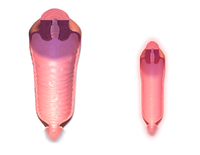
Photo from wikipedia
BackgroundThe incidence of anal abscess and fistula is relatively high, and the condition is most common in young men.MethodsThis is a revised version of the German S3 guidelines first published… Click to show full abstract
BackgroundThe incidence of anal abscess and fistula is relatively high, and the condition is most common in young men.MethodsThis is a revised version of the German S3 guidelines first published in 2011. It is based on a systematic review of pertinent literature.ResultsCryptoglandular abscesses and fistulas usually originate in the proctodeal glands of the intersphincteric space. Classification depends on their relation to the anal sphincter. Patient history and clinical examination are diagnostically sufficient in order to establish the indication for surgery. Further examinations (endosonography, MRI) should be considered in complex abscesses or fistulas. The goal of surgery for an abscess is thorough drainage of the focus of infection while preserving the sphincter muscles. The risk of abscess recurrence or secondary fistula formation is low overall. However, they may result from insufficient drainage. Primary fistulotomy should only be performed in case of superficial fistulas. Moreover, it should be done by experienced surgeons. In case of unclear findings or high fistulas, repair should take place in a second procedure. Anal fistulas can be treated only by surgical intervention with one of the following operations: laying open, seton drainage, plastic surgical reconstruction with suturing of the sphincter (flap, sphincter repair, LIFT), and occlusion with biomaterials. Only superficial fistulas should be laid open. The risk of postoperative incontinence is directly related to the thickness of the sphincter muscle that is divided. All high anal fistulas should be treated with a sphincter-saving procedure. The various plastic surgical reconstructive procedures all yield roughly the same results. Occlusion with biomaterial results in lower cure rate.ConclusionIn this revision of the German S3 guidelines, instructions for diagnosis and treatment of anal abscess and fistula are described based on a review of current literature.
Journal Title: Langenbeck's Archives of Surgery
Year Published: 2017
Link to full text (if available)
Share on Social Media: Sign Up to like & get
recommendations!